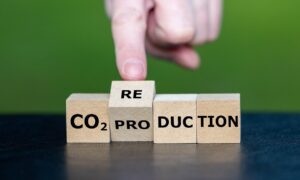Carbon claims: Get the language right and the facts straight
-thinkstep-anz
 If you’re sharing your organisation’s carbon footprint, net zero goals or carbon neutral status, it’s vital to communicate clearly and accurately. Getting it wrong could damage your reputation, open you up to legal risk or erode trust with your customers and stakeholders.
If you’re sharing your organisation’s carbon footprint, net zero goals or carbon neutral status, it’s vital to communicate clearly and accurately. Getting it wrong could damage your reputation, open you up to legal risk or erode trust with your customers and stakeholders.
Strong carbon claims can show leadership, but only if they’re backed by real action and solid evidence. The good news is: once you understand the terms, it’s much easier to get them right.
Why clarity matters more than ever
In today’s fast-moving policy and regulatory environment, environmental claims are under increasing scrutiny. We’ve seen businesses taken to court for inaccurate or unsubstantiated claims.
To stay on the right side of the law – and the right side of your customers – you need to be cautious and well-informed.
This article explains the key carbon terms and offers practical advice to help manufacturers communicate responsibly.
What the key carbon terms mean
Carbon neutral
Your business, product or service has measured its emissions, taken action to reduce them and used offsets to balance what’s left.
- You need: a defined scope (e.g. your head office or a specific product line), a timeframe, a verified carbon footprint and a credible reduction plan.
- Use offsets only for emissions you genuinely can’t avoid, after reduction efforts.
- Standard to follow: ISO 14068.
Example:
A manufacturer measures and verifies its emissions for 2023, reduces what it can and offsets the rest using certified carbon credits. It communicates: “Carbon neutral for our Christchurch site in 2023, certified to ISO 14068.”
Net carbon zero
This means deep emissions cuts first, and offsets only for what’s unavoidable. It’s typically applied to entire organisations.
- You need: to follow the Science Based Targets initiative (SBTi) approach – prioritising genuine emissions reductions. Offsetting alone is not enough. You must reduce most of your footprint through meaningful changes (e.g. cleaner energy, efficient transport).
Example:
A manufacturer reduces emissions by 90% by upgrading equipment and switching to renewable energy. The remaining 10% is offset. That’s a credible net carbon zero claim.
Zero carbon
This means no carbon emissions are generated at all across the entire lifecycle. It’s extremely difficult to achieve.
- Requires zero emissions from raw material extraction through to end-of-life.
Example:
A wind turbine manufactured and transported using only renewable energy might come close – but most businesses won’t be able to meet this threshold.
Carbon negative / Carbon positive
These terms mean you’re removing more carbon from the atmosphere than you emit.
- Carbon negative is clearer and more accurate.
- Carbon positive is used interchangeably but can be confusing, so it is best avoided.
Example:
A timber business plants permanent native forests that sequester more carbon than the emissions from harvesting, milling, and transport. Independent third-party verification supports the carbon negative claim.
Carbon credits and offsets
What is a carbon credit?
A carbon credit represents one tonne of carbon dioxide equivalent (CO₂e) reduced, removed, or avoided by a certified project. This could be through tree planting, renewable energy or methane capture.
What are carbon offset?
A carbon offset is when you buy a carbon credit to balance out emissions you produce. It only works if the offset project is real and measurable.
So how can you do it right?
Here’s how to communicate responsibly and avoid greenwashing:
- Use accurate, consistent language
Know the difference between net zero, carbon neutral, and climate neutral. Use them correctly and consistently and avoid vague claims. Saying “we’re carbon neutral” isn’t enough. Explain what that means, how you achieved it and what standards you followed.
- Follow the standards -not just loosely
Look for ISO 14068 for carbon neutrality, ISO 14067 for product footprints, and ISO 14064 for organisational footprints. Don’t say “aligned with ISO”. Follow the relevant standards properly if you want your claims to hold up.
- Use high-quality offsets and be upfront about them
Offsetting is a useful tool, but only when you’ve done everything you can to reduce emissions first. Share details about the projects and be clear on what they actually achieve.
Make sure offsets are additional, impactful and verified. Check if they’re listed on recognised registries like Gold Standard or Verra.
- Tell the whole story
Avoid vague promises and future goals without a credible plan and verified data to support them. If you’re just starting your sustainability journey, that’s okay. Be open about what you’ve measured, what you haven’t and what you’re working on. That builds trust.
Even if you’re a small business without certification, you can still tell a credible story. Just be clear and honest about where you’re at.
Want a second opinion?
thinkstep-anz now offers a fixed-price carbon claim review service. It’s designed to help businesses sense-check their claims, avoid risk and communicate confidently. Learn more here.



